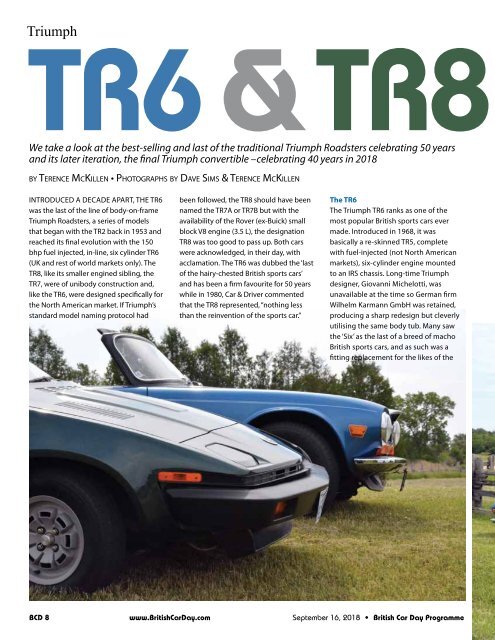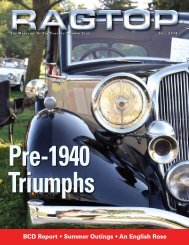You also want an ePaper? Increase the reach of your titles
YUMPU automatically turns print PDFs into web optimized ePapers that Google loves.
Triumph<br />
TR6 & TR8<br />
We take a look at the best-selling and last of the traditional Triumph Roadsters celebrating 50 years<br />
and its later iteration, the final Triumph convertible –celebrating 40 years in <strong>2018</strong><br />
by Terence McKillen • Photographs by Dave Sims & Terence McKillen<br />
Introduced a decade apart, the TR6<br />
was the last of the line of body-on-frame<br />
Triumph Roadsters, a series of models<br />
that began with the TR2 back in 1953 and<br />
reached its final evolution with the 150<br />
bhp fuel injected, in-line, six cylinder TR6<br />
(UK and rest of world markets only). The<br />
TR8, like its smaller engined sibling, the<br />
TR7, were of unibody construction and,<br />
like the TR6, were designed specifically for<br />
the North American market. If Triumph’s<br />
standard model naming protocol had<br />
been followed, the TR8 should have been<br />
named the TR7A or TR7B but with the<br />
availability of the Rover (ex-Buick) small<br />
block V8 engine (3.5 L), the designation<br />
TR8 was too good to pass up. Both cars<br />
were acknowledged, in their day, with<br />
acclamation. The TR6 was dubbed the ‘last<br />
of the hairy-chested British sports cars’<br />
and has been a firm favourite for 50 years<br />
while in 1980, Car & Driver commented<br />
that the TR8 represented, “nothing less<br />
than the reinvention of the sports car.”<br />
The TR6<br />
The Triumph TR6 ranks as one of the<br />
most popular British sports cars ever<br />
made. Introduced in 1968, it was<br />
basically a re-skinned TR5, complete<br />
with fuel-injected (not North American<br />
markets), six-cylinder engine mounted<br />
to an IRS chassis. Long-time Triumph<br />
designer, Giovanni Michelotti, was<br />
unavailable at the time so German firm<br />
Wilhelm Karmann GmbH was retained,<br />
producing a sharp redesign but cleverly<br />
utilising the same body tub. Many saw<br />
the ‘Six’ as the last of a breed of macho<br />
British sports cars, and as such was a<br />
fitting replacement for the likes of the<br />
Austin Healey 3000, which had ceased<br />
production in 1968, just before the<br />
TR6’s release.<br />
In period, more TR6s were<br />
produced than any TR model<br />
before it. The last fuel-injected TR6<br />
was made in February 1975, while<br />
production of the ‘Federal’ car continued<br />
on in carburetted format and with everincreasing<br />
emissions strangulation until<br />
July 1976, although in fairness Triumph<br />
managed to hold on to an output of 104-<br />
106 bhp throughout. When it was finally<br />
replaced by the TR7, 94,619 examples<br />
of the Six had rolled off the Canley<br />
production line. A contemporary road test<br />
noted “the protesting creaks and groans<br />
from a chassis which still does not feel<br />
completely rigid on really rough roads.”<br />
Although the Karman designed<br />
body was different from the preceding<br />
TR5 and 4 models, it cleverly was not<br />
as different as first appearances might<br />
suggest. The TR6 essentially received new<br />
front and rear sections while the centre<br />
section remained as the old TR4/5/250.<br />
The German studio redesigned the TR6<br />
to utilise many of the existing body<br />
pressings. The external boot and bonnet<br />
shapes were changed significantly<br />
resulting in more luggage space, however,<br />
the existing scuttle, doors and inner<br />
panels were retained.<br />
The front and back had a more<br />
squared-off look with a matte-black rear<br />
valance<br />
and with<br />
the headlights<br />
moved out to the wing edges,<br />
resulting in a more aggressive appearance<br />
and finally shedding the rounded design<br />
of the earlier TRs. Triumph retained the<br />
2.5 litre in-line six-cylinder engine and<br />
added a front anti-roll bar and wider (5½<br />
J) wheels, the latter giving the car a lower,<br />
leaner look. The contemporary advertising<br />
by Triumph claimed that the “TR6 beats<br />
any previous TR for road holding, and<br />
that’s really saying something.”<br />
In the cockpit, the facia<br />
and trim followed that of the<br />
TR250 except the ammeter<br />
became a voltmeter and the<br />
instruments changed from<br />
the needle hanging down<br />
to being upright and bezels<br />
went back to being chromed.<br />
The ignition key migrated<br />
from a central position on<br />
the facia to the lower side<br />
of the steering column as<br />
a steering lock was added.<br />
Seating<br />
was improved<br />
with contoured and<br />
adjustable bucket seats<br />
with headrests provided<br />
in the Federal specification<br />
models. For some reason, the fuel tank<br />
got smaller, with only a 43 litre capacity<br />
compared to the 53 litres of the TR4A.<br />
The UK CP series (with PI), produced<br />
from 1969 to 1972, had a nominal 150 bhp<br />
output at 5500 rpm. The corresponding<br />
North American models, the CC series<br />
(twin carb) had a nominal output of 106<br />
bhp at 4900 rpm. The 1973 to 1976 UK<br />
<strong>BCD</strong> 8 www.BritishCarDay.com September 16, <strong>2018</strong> • British Car Day Programme<br />
Ragtop I Summer I 2013 www.TorontoTriumph.com 9



